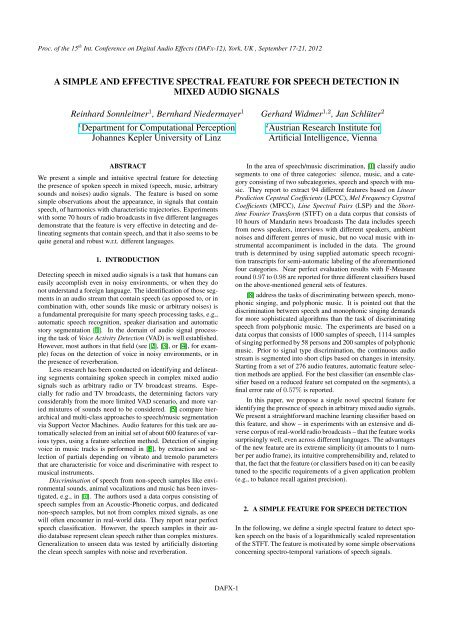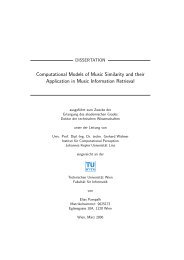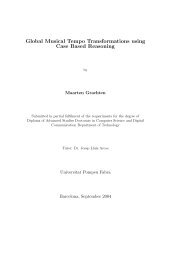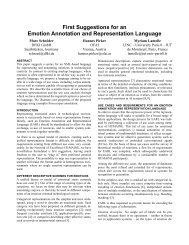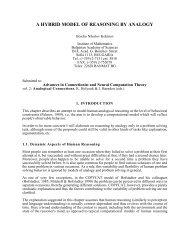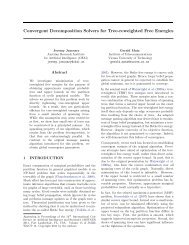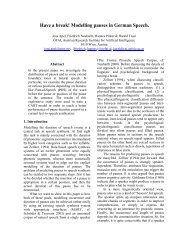A Simple and Effective Spectral Feature for Speech Detection ... - OFAI
A Simple and Effective Spectral Feature for Speech Detection ... - OFAI
A Simple and Effective Spectral Feature for Speech Detection ... - OFAI
Create successful ePaper yourself
Turn your PDF publications into a flip-book with our unique Google optimized e-Paper software.
Proc. of the 15 th Int. Conference on Digital Audio Effects (DAFx-12), York, UK , September 17-21, 2012<br />
A SIMPLE AND EFFECTIVE SPECTRAL FEATURE FOR SPEECH DETECTION IN<br />
MIXED AUDIO SIGNALS<br />
Reinhard Sonnleitner 1 , Bernhard Niedermayer 1<br />
1 Department <strong>for</strong> Computational Perception<br />
Johannes Kepler University of Linz<br />
Gerhard Widmer 1,2 , Jan Schlüter 2<br />
2 Austrian Research Institute <strong>for</strong><br />
Artificial Intelligence, Vienna<br />
ABSTRACT<br />
We present a simple <strong>and</strong> intuitive spectral feature <strong>for</strong> detecting<br />
the presence of spoken speech in mixed (speech, music, arbitrary<br />
sounds <strong>and</strong> noises) audio signals. The feature is based on some<br />
simple observations about the appearance, in signals that contain<br />
speech, of harmonics with characteristic trajectories. Experiments<br />
with some 70 hours of radio broadcasts in five different languages<br />
demonstrate that the feature is very effective in detecting <strong>and</strong> delineating<br />
segments that contain speech, <strong>and</strong> that it also seems to be<br />
quite general <strong>and</strong> robust w.r.t. different languages.<br />
1. INTRODUCTION<br />
Detecting speech in mixed audio signals is a task that humans can<br />
easily accomplish even in noisy environments, or when they do<br />
not underst<strong>and</strong> a <strong>for</strong>eign language. The identification of those segments<br />
in an audio stream that contain speech (as opposed to, or in<br />
combination with, other sounds like music or arbitrary noises) is<br />
a fundamental prerequisite <strong>for</strong> many speech processing tasks, e.g.,<br />
automatic speech recognition, speaker diarisation <strong>and</strong> automatic<br />
story segmentation [1]. In the domain of audio signal processing<br />
the task of Voice Activity <strong>Detection</strong> (VAD) is well established.<br />
However, most authors in that field (see [2], [3], or [4], <strong>for</strong> example)<br />
focus on the detection of voice in noisy environments, or in<br />
the presence of reverberation.<br />
Less research has been conducted on identifying <strong>and</strong> delineating<br />
segments containing spoken speech in complex mixed audio<br />
signals such as arbitrary radio or TV broadcast streams. Especially<br />
<strong>for</strong> radio <strong>and</strong> TV broadcasts, the determining factors vary<br />
considerably from the more limited VAD scenario, <strong>and</strong> more varied<br />
mixtures of sounds need to be considered. [5] compare hierarchical<br />
<strong>and</strong> multi-class approaches to speech/music segmentation<br />
via Support Vector Machines. Audio features <strong>for</strong> this task are automatically<br />
selected from an initial set of about 600 features of various<br />
types, using a feature selection method. <strong>Detection</strong> of singing<br />
voice in music tracks is per<strong>for</strong>med in [6], by extraction <strong>and</strong> selection<br />
of partials depending on vibrato <strong>and</strong> tremolo parameters<br />
that are characteristic <strong>for</strong> voice <strong>and</strong> discriminative with respect to<br />
musical instruments.<br />
Discrimination of speech from non-speech samples like environmental<br />
sounds, animal vocalizations <strong>and</strong> music has been investigated,<br />
e.g., in [7]. The authors used a data corpus consisting of<br />
speech samples from an Acoustic-Phonetic corpus, <strong>and</strong> dedicated<br />
non-speech samples, but not from complex mixed signals, as one<br />
will often encounter in real-world data. They report near perfect<br />
speech classification. However, the speech samples in their audio<br />
database represent clean speech rather than complex mixtures.<br />
Generalization to unseen data was tested by artificially distorting<br />
the clean speech samples with noise <strong>and</strong> reverberation.<br />
In the area of speech/music discrimination, [1] classify audio<br />
segments to one of three categories: silence, music, <strong>and</strong> a category<br />
consisting of two subcategories, speech <strong>and</strong> speech with music.<br />
They report to extract 94 different features based on Linear<br />
Prediction Cepstral Coefficients (LPCC), Mel Frequency Cepstral<br />
Coefficients (MFCC), Line <strong>Spectral</strong> Pairs (LSP) <strong>and</strong> the Shorttime<br />
Fourier Trans<strong>for</strong>m (STFT) on a data corpus that consists of<br />
10 hours of M<strong>and</strong>arin news broadcasts The data includes speech<br />
from news speakers, interviews with different speakers, ambient<br />
noises <strong>and</strong> different genres of music, but no vocal music with instrumental<br />
accompaniment is included in the data. The ground<br />
truth is determined by using supplied automatic speech recognition<br />
transcripts <strong>for</strong> semi-automatic labeling of the a<strong>for</strong>ementioned<br />
four categories. Near perfect evaluation results with F-Measure<br />
round 0.97 to 0.98 are reported <strong>for</strong> three different classifiers based<br />
on the above-mentioned general sets of features.<br />
[8] address the tasks of discriminating between speech, monophonic<br />
singing, <strong>and</strong> polyphonic music. It is pointed out that the<br />
discrimination between speech <strong>and</strong> monophonic singing dem<strong>and</strong>s<br />
<strong>for</strong> more sophisticated algorithms than the task of discriminating<br />
speech from polyphonic music. The experiments are based on a<br />
data corpus that consists of 1000 samples of speech, 1114 samples<br />
of singing per<strong>for</strong>med by 58 persons <strong>and</strong> 200 samples of polyphonic<br />
music. Prior to signal type discrimination, the continuous audio<br />
stream is segmented into short clips based on changes in intensity.<br />
Starting from a set of 276 audio features, automatic feature selection<br />
methods are applied. For the best classifier (an ensemble classifier<br />
based on a reduced feature set computed on the segments), a<br />
final error rate of 0.57% is reported.<br />
In this paper, we propose a single novel spectral feature <strong>for</strong><br />
identifying the presence of speech in arbitrary mixed audio signals.<br />
We present a straight<strong>for</strong>ward machine learning classifier based on<br />
this feature, <strong>and</strong> show – in experiments with an extensive <strong>and</strong> diverse<br />
corpus of real-world radio broadcasts – that the feature works<br />
surprisingly well, even across different languages. The advantages<br />
of the new feature are its extreme simplicity (it amounts to 1 number<br />
per audio frame), its intuitive comprehensibility <strong>and</strong>, related to<br />
that, the fact that the feature (or classifiers based on it) can be easily<br />
tuned to the specific requirements of a given application problem<br />
(e.g., to balance recall against precision).<br />
2. A SIMPLE FEATURE FOR SPEECH DETECTION<br />
In the following, we define a single spectral feature to detect spoken<br />
speech on the basis of a logarithmically scaled representation<br />
of the STFT. The feature is motivated by some simple observations<br />
concerning spectro-temporal variations of speech signals.<br />
DAFX-1
Proc. of the 15 th Int. Conference on Digital Audio Effects (DAFx-12), York, UK , September 17-21, 2012<br />
2.1. Observations on <strong>Speech</strong> Signals<br />
When comparing the spectrogram of a speech signal to signals representing<br />
music or noise, one will observe a number of specific<br />
characteristics.<br />
• First, speech signals usually display patterns relating to the<br />
presence of several harmonics, that are influenced by the<br />
shape of the vocal tract. Within an individual time frame,<br />
they manifest themselves in the <strong>for</strong>m of significant peaks<br />
within the spectrum. This behavior is similar to the sound<br />
produced by (pitched) musical instruments. There, partials<br />
can be found at the fundamental frequency f 0 of a tone <strong>and</strong><br />
also near its integer multiples (n + 1)f 0, with n ∈ N or<br />
n ∈ N e <strong>for</strong> string or wind instruments, respectively.<br />
• A second important observation is that the harmonics are<br />
sustained over a certain span of time in which they are very<br />
likely to vary in frequency. This is a discriminative characteristic<br />
of speech in comparison to noise or the sound of<br />
musical instruments. Noise, on the one h<strong>and</strong>, does generally<br />
not reveal significant spectral peaks which are sustained<br />
over time. Musical instruments, on the other h<strong>and</strong>,<br />
are used to play tones on a discrete pitch scale. A corresponding<br />
audio signal will, there<strong>for</strong>e, consist of partials<br />
with a relatively constant frequency. 1 Exceptions to this<br />
are specific effects like gliss<strong>and</strong>i <strong>and</strong> – a somewhat more<br />
serious problem <strong>for</strong> speech/music discrimination – vibrato.<br />
(We will return to this issue in Section 4 below.)<br />
In Figure 1, one can clearly recognize the characteristic curved<br />
trajectories in the spectrogram computed from the speech signal.<br />
In contrast, the music sample is characterized by strictly horizontal<br />
<strong>and</strong> minor vertical structures in the lower frequency regions, i.e.,<br />
the partials at the harmonic frequencies of notes <strong>and</strong> the respective<br />
transient note onsets. The third sample shows the frequency<br />
components present in traffic noise. Here, one cannot identify any<br />
dominant pattern.<br />
Based upon those observations, we propose to identify human<br />
voice within mixed audio signals by detecting the curved frequency<br />
trajectory of the harmonics over a certain period of time.<br />
2.2. <strong>Feature</strong> Computation<br />
The basic idea behind the feature we propose is to capture sustained<br />
harmonics’ trajectories which – in contrast to the partials of<br />
a note played on a musical instrument – vary in frequency. Both<br />
phenomena result in a high correlation when comparing the spectral<br />
patterns of two nearby audio frames. There<strong>for</strong>e, each time<br />
frame X t is compared to a subsequent one X t+offset . However, in<br />
order to allow <strong>for</strong> the curved frequency trajectories of speech harmonics,<br />
frequency shifts have to be accounted <strong>for</strong>. We do this by<br />
computing the cross-correlation between the two time frames X t<br />
<strong>and</strong> X t+offset . The cross-correlation can be used to estimate the<br />
degree of correlation between shifted versions of these vectors, <strong>for</strong><br />
a range of so-called lags l. Given two vectors x <strong>and</strong> y of length<br />
N, the cross-correlation <strong>for</strong> all lags l ∈ [−N, N] including zerolag,<br />
as given in Equation 1, results in a cross-correlation series of<br />
length 2N + 1.<br />
R xy(l) = ∑ x iy i+l (1)<br />
i<br />
1 In [9], this is exploited in a feature called Continuous Frequency Activation<br />
(CFA) <strong>for</strong> (<strong>for</strong>eground <strong>and</strong> background) music detection in TV<br />
broadcasts.<br />
In our case the input vectors are time frames, <strong>and</strong> the lag corresponds<br />
to a shift along the frequency axis. We define r xcorr as the<br />
maximum cross-correlation over a range of lags:<br />
r xcorr (X t, X t+offset ) = max R Xt ,X t+offset<br />
(l) (2)<br />
l<br />
where l ∈ [−l max, l max] denotes the lag (frequency shift) in<br />
terms of frequency bins. We define r as a special case of the crosscorrelation<br />
mentioned above, with lag l = 0 , <strong>and</strong> subsequently<br />
refer to zero-lag cross-correlation as correlation:<br />
r(X t, X t+offset ) = R Xt ,X t+offset<br />
(0) (3)<br />
As an indicator of the dominance of speech in an audio signal,<br />
we introduce the correlation gain r xcorr − r. For ‘ideal’ musiconly<br />
signals (i.e, those dominated by horizontal tone patterns in<br />
the spectrum), the cross-correlation will have its maximum <strong>for</strong><br />
frequency lag 0, <strong>and</strong> thus the gain r xcorr − r = R(0) − r =<br />
r − r = 0. For signals dominated by curved harmonic patterns,<br />
R(l) will be maximal <strong>for</strong> some l ≠ 0 <strong>and</strong> there will be a positive<br />
gain r xcorr − r. For audio recordings where musical instruments<br />
dominate the contribution of speech to the signal the gain<br />
is lowered. Here, harmonics of varying frequency are mixed with<br />
partials of constant frequency. For sections containing noise only,<br />
the correlation between nearby time frames is generally expected<br />
to be low. Also, it is unlikely that a frequency shift will yield significantly<br />
higher correlations due to the r<strong>and</strong>omness of the energy<br />
distribution over time in such signals.<br />
Since harmonic frequencies are multiples of the fundamental<br />
frequency, shifting spectral patterns along the frequency axis<br />
cannot be done on a linear scale: the lag parameter in the crosscorrelation<br />
<strong>for</strong>mula can only represent the frequency derivative<br />
∆f of one single harmonic; <strong>for</strong> the other harmonics this derivative<br />
would be a multiple c k ∆f. However, when frequencies are represented<br />
on a logarithmic scale, harmonics are at constant offsets<br />
relative to their fundamental frequency, so continuous frequency<br />
changes can be captured by cross-correlation as described above.<br />
We prepare our data corpus <strong>for</strong> subsequent computations by<br />
sampling the input to 22.05 kHz monaural audio. To extract the<br />
spectral feature, we trans<strong>for</strong>m the audio input to the frequency domain<br />
by applying a Short Time Fourier Trans<strong>for</strong>m with a Kaiser<br />
window of a size of 4096 samples. For subsequent computations<br />
in the feature extraction process, we follow the preprocessing steps<br />
as per<strong>for</strong>med in [9], by computing the magnitude spectrum |X(f)|<br />
<strong>and</strong> mapping the STFT magnitude spectrum to a perceptual scale.<br />
For our implementation we have chosen the logarithmic cent scale<br />
representation of STFT spectrograms. Also, the feature extraction<br />
process considers the lower 150 cent-scaled frequency bins of the<br />
spectrum only, which corresponds to frequencies of up to roughly<br />
802 Hz, while discarding the upper bins.<br />
Using this configuration we found that comparing an audio<br />
frame to its direct successor does not yield the expected results.<br />
The hop size chosen <strong>for</strong> the STFT corresponds to a time difference<br />
of approximately 23 ms. During such a small time span the<br />
harmonics’ frequencies do not vary significantly enough to permit<br />
a reliable discrimination from partials of notes played by musical<br />
instruments. There<strong>for</strong>e, the parameter offset in the computation<br />
of the cross-correlation (cf. Equation 2) was chosen to be 3.<br />
Another parameter that has to be selected is the maximum lag<br />
l max used <strong>for</strong> computing the cross-correlation (cf. Equation 2).<br />
We propose to set this parameter such that it does not allow <strong>for</strong> the<br />
shift of an entire semitone, which in our case gives us an l max of<br />
DAFX-2
Proc. of the 15 th Int. Conference on Digital Audio Effects (DAFx-12), York, UK , September 17-21, 2012<br />
(a) <strong>Speech</strong> (b) Music (c) Traffic Noise<br />
Figure 1: Comparison of the spectrograms of sections containing (a) speech, (b) popular music including singing voice, <strong>and</strong> (c) traffic<br />
noise. The length of each section is approximately 7 seconds <strong>and</strong> the frequencies range from 100 Hz to 3000 Hz on a logarithmic scale.<br />
3. This prevents the feature from reporting high values at times<br />
where a musical instrument plays along a chromatic scale.<br />
Figure 2 demonstrates the behavior of our feature. We show<br />
intermediate results of the feature computation process, <strong>for</strong> two<br />
different exemplary kinds of audio input: a transition from speech<br />
to music is shown in the left half of the figure, a Pop song with<br />
female sung voice is depicted on the right. Once again, note that<br />
the cross-correlation value <strong>for</strong> lag l = 0 corresponds to the ‘regular’<br />
correlation. Thus, in the plots in the second row of Fig. 2,<br />
which show the cross-correlation values <strong>for</strong> different lags l (vertical<br />
dimension, in the range of l ∈ [−3, 3]), high values in the<br />
central row (l = 0) indicate high correlation, whereas high values<br />
<strong>for</strong> rows with l ≠ 0 are possible indicators of speech. The <strong>for</strong>mer<br />
can clearly be seen in the music examples (first half of plot on<br />
left-h<strong>and</strong> side, <strong>and</strong> entire plot on right-h<strong>and</strong> side). The latter case<br />
can be observed in the second half of the plot on the left, where<br />
the presence of curved harmonic patterns in the spectrogram leads<br />
to relatively high cross-correlation values <strong>for</strong> lags l < 0 – higher,<br />
at any rate, than the correlation at lag l = 0. The resulting correlation<br />
gain r xcorr − r, shown at the bottom of the figure, then<br />
identifies exactly those areas that exhibit strong curved patterns.<br />
(The somewhat spiky nature of the gain function also explains why<br />
we will apply some smoothing to this curve when computing the<br />
actual features <strong>for</strong> the classifier – see below).<br />
2.3. The Final <strong>Feature</strong>: Context Integration <strong>and</strong> Smoothing<br />
We compute the feature from the audio signal according to a decision<br />
frequency of 5 Hz (i.e., one feature value every 200 ms),<br />
where we center an observation window of width 50 STFT blocks<br />
(approximately 1.3s) around each decision position, in order to<br />
also capture some context.<br />
For each of the N−offset pairs of STFT blocks (X t, X t+offset )<br />
in the observation window of length N, two vectors xc, c of feature<br />
values, one <strong>for</strong> the cross-correlation <strong>and</strong> one <strong>for</strong> the correlation<br />
results, are computed, both having a length of N − offset,<br />
where N is the number of STFT blocks of the observation window<br />
(50, in our case). The element-wise difference of the vectors<br />
gives the feature vector r = xc − c. Finally, r is smoothed using<br />
a rectangular window of width 5, <strong>and</strong> the index of the dominant<br />
frequency bin within the observation window is appended to the<br />
feature vector as an additional feature. Preliminary experiments<br />
showed that this increases the ratio of correctly classified instances<br />
by roughly one percentage point. Thus, the final result is a vector<br />
of 48 feature values (50 − 3 smoothed correlation gain values, <strong>and</strong><br />
1 frequency bin index) per decision point. The size of the observation<br />
window allows us to capture enough context to detect spoken<br />
speech, <strong>and</strong> carries overlap <strong>for</strong> effective smoothing that can be applied<br />
as a post-processing step.<br />
3.1. Classification Scenario<br />
3. EXPERIMENTAL RESULTS<br />
We test our feature in a classical machine learning approach, by<br />
training a classifier on a manually annotated ground truth (radio<br />
broadcast recordings with segment boundary indications) <strong>for</strong> a basic<br />
two-class problem, namely <strong>for</strong> the classes contains speech <strong>and</strong><br />
does not contain speech. The used classifier model is a r<strong>and</strong>om<br />
<strong>for</strong>est [10] (an ensemble classifier of decision trees that outputs<br />
the mode of the decisions of its respective trees), parameterized to<br />
use 200 decision trees, <strong>and</strong> 10 r<strong>and</strong>om features per tree. The classifier<br />
outputs class probabilities, which are trans<strong>for</strong>med to binary<br />
decisions using simple thresholding.<br />
We prepare three data sets: a training set, to be used as training<br />
material <strong>for</strong> the classifier; a validation set, which will be used<br />
to per<strong>for</strong>m systematic parameter studies, <strong>and</strong> to select the final parameter<br />
setting (in particular, the decision threshold); <strong>and</strong> an independent<br />
test set, on which the final classifier will then be evaluated.<br />
The classifier is trained to classify individual time points in the<br />
audio stream — in other words, each training example is one point<br />
in the audio, represented in terms of a feature vector of 48 feature<br />
values, as explained above, where the feature values characterize<br />
the signal at the current point, <strong>and</strong> its local context.<br />
Training, validation, <strong>and</strong> test data are processed with a feature<br />
extraction frequency of 5 Hz, which means that the classifier<br />
produces predictions at a rate of 5 labels per second of audio. As<br />
a post-processing step, the sequence of predicted class labels is<br />
smoothed using a median filter with a window size of 52 labels.<br />
3.2. The Data Corpus<br />
The main data corpus consists of recordings of 61 hours of r<strong>and</strong>omly<br />
selected radio broadcasts, recorded in three batches (each<br />
relating to a different week) from six different radio stations in<br />
DAFX-3
Proc. of the 15 th Int. Conference on Digital Audio Effects (DAFx-12), York, UK , September 17-21, 2012<br />
150<br />
FM4−h1.wav; lower 150 cent bins;4.8065s at second1209<br />
150<br />
FM4−h3.wav; lower 150 cent bins;4.8065s at second854<br />
100<br />
100<br />
50<br />
50<br />
20 40 60 80 100 120 140 160 180 200<br />
20 40 60 80 100 120 140 160 180 200<br />
Cross−correlation, offset=3, maxlag=3<br />
Cross−correlation, offset=3, maxlag=3<br />
2<br />
2<br />
0<br />
0<br />
−2<br />
−2<br />
20 40 60 80 100 120 140 160 180<br />
20 40 60 80 100 120 140 160 180<br />
0.01<br />
vector of max(result) over each column<br />
xcorr<br />
corr<br />
0.01<br />
vector of max(result) over each column<br />
xcorr<br />
corr<br />
0.005<br />
0.005<br />
0<br />
0 20 40 60 80 100 120 140 160 180 200<br />
0<br />
0 20 40 60 80 100 120 140 160 180 200<br />
x Result: (xcorr − corr), smoothed<br />
10−4<br />
8<br />
6<br />
4<br />
2<br />
0<br />
0 20 40 60 80 100 120 140 160 180 200<br />
(a) Music-<strong>Speech</strong> transition<br />
x Result: (xcorr − corr), smoothed<br />
10−4<br />
8<br />
6<br />
4<br />
2<br />
0<br />
0 20 40 60 80 100 120 140 160 180 200<br />
(b) Music <strong>and</strong> sung voice<br />
Figure 2: Comparison of the feature values <strong>for</strong> sections containing (a) music <strong>and</strong> then spoken speech <strong>and</strong> (b) music with singing voice<br />
(duration: approximately 5 seconds each). The top row shows the spectrograms (the lower 150 bins of the cent scale) of the two audio<br />
snippets. The second row shows the resulting cross-correlation values R(l) <strong>for</strong> offset = 3 <strong>and</strong> lag values l ∈ [−3, 3]. The third row<br />
compares the corresponding values r(= R(0)) (dashed line) <strong>and</strong> r xcorr = max l R(l) (solid line). The bottom row plots the correlation<br />
gain r xcorr − r, which is the basis <strong>for</strong> our proposed feature.<br />
Switzerl<strong>and</strong> (drsvirus, RSI Rete 2, RSR Couleur 3, Radio Central,<br />
Radio Chablais, RTR Rumantsch), which together represent all<br />
four official languages of Switzerl<strong>and</strong>: (Swiss) German, French,<br />
Italian <strong>and</strong> Rumantsch. The recordings were split into files with a<br />
duration of 30 minutes each, <strong>and</strong> manually annotated according to<br />
the two-class problem of ‘spoken speech’ vs. ‘other’, where ‘spoken<br />
speech’ refers to all segments which contain speech, even if<br />
mixed with other sounds or music (such as when a radio host introduces<br />
a song while it is already playing). 2 Note that this classi-<br />
2 Of course, the distinction between speech <strong>and</strong> non-speech is not always<br />
entirely clear, <strong>and</strong> neither are the exact boundaries where a speech<br />
signal ends or begins. (As as simple example, consider pauses in between<br />
sentences. In a sense, these are a natural part of the way we speak; but if<br />
such pauses grow longer, at some (rather arbitrary) point we will have to<br />
classify them as non-speech.) This observation, in fact, makes us slightly<br />
skeptical of some of the results in the literature, where recognition accuracies<br />
in speech/non-speech segmentation of 100% or almost 100% are<br />
reported. Our own preliminary experiments with multiple annotators per<br />
fication problem is considerably more difficult that distinguishing<br />
pure speech samples from pure music or noise samples.<br />
The training set consists of 21 hours of audio (42 half hour<br />
files, 7 files from each radio station) r<strong>and</strong>omly selected from the<br />
first two Swiss week batches. The validation set comprises 18 half<br />
hour files (3 per station). The r<strong>and</strong>om <strong>for</strong>est classifier is trained on<br />
the manually annotated ground truth; thresholds as well as postprocessing<br />
parameters are chosen empirically using the validation<br />
set.<br />
The audio files <strong>for</strong> the independent test set were recorded two<br />
weeks after training <strong>and</strong> validation data. The test set is made up<br />
of 31 hours of previously unseen broadcast material, split into 62<br />
files, distributed almost uni<strong>for</strong>mly over the 6 radio stations.<br />
Finally, to further test the robustness of the feature in relation<br />
to different languages <strong>and</strong> dialects, we recorded an additional 9<br />
audio file indicate an inter-annotator variability of up to 2%. Thus, not<br />
even the so-called ground truth is 100% reliable (nor can it be).<br />
DAFX-4
Proc. of the 15 th Int. Conference on Digital Audio Effects (DAFx-12), York, UK , September 17-21, 2012<br />
1.0<br />
1.0<br />
0.9<br />
1.0<br />
0.8<br />
0.8<br />
0.8<br />
0.7<br />
0.8<br />
Accuracy<br />
0.6<br />
0.4<br />
Recall<br />
0.6<br />
0.4<br />
0.6<br />
0.5<br />
0.4<br />
0.3<br />
F-Score<br />
0.6<br />
0.4<br />
0.2<br />
0.2<br />
0.2<br />
0.2<br />
0.1<br />
0.0<br />
0.0 0.2 0.4 0.6 0.8 1.0<br />
threshold<br />
0.0<br />
0.0 0.2 0.4 0.6 0.8 1.0<br />
Precision<br />
0.0<br />
0.0<br />
0.0 0.2 0.4 0.6 0.8 1.0<br />
threshold<br />
(a) Accuracy<br />
(b) Precision / Recall<br />
(c) F-score<br />
Figure 3: Accuracy, Precision vs. Recall <strong>and</strong> F-measure plots <strong>for</strong> thresholds t ∈ [0.0, 1.0], showing the robustness of the spoken speech<br />
feature. In plot (b), the thresholds are indicated by colors.<br />
hours of radio material from Switzerl<strong>and</strong>’s neighbor country Austria<br />
(3 stations: Oe1, Oe3, LiveRadio). The class distributions <strong>and</strong><br />
segment counts <strong>for</strong> the various data sets are given in Table 2.<br />
are generally rather high <strong>and</strong> testify to the power of our simple<br />
audio feature. Clearly, though, there is still some room <strong>for</strong> further<br />
improvement, which we will address in future research.<br />
3.3. Results<br />
Figure 3 shows how the results on the validation set change as we<br />
vary the decision threshold <strong>for</strong> the classifier. (Remember that the<br />
classifier outputs a probability value between 0 <strong>and</strong> 1 <strong>for</strong> a given<br />
example, which is then turned into a binary class prediction by<br />
thresholding.) The classifier turns out to be extraordinarily stable<br />
<strong>for</strong> a wide range of decision thresholds between 0.2 <strong>and</strong> 0.8. As<br />
a consequence, we rather arbitrarily selected a threshold of 0.5 <strong>for</strong><br />
our remaining evaluation on independent test sets.<br />
The results of the resulting classifier on the validation <strong>and</strong> test<br />
sets are summarised <strong>and</strong> compared in Table 1. Given the complexity<br />
of the signals <strong>and</strong> the task (which we are keenly aware of, having<br />
annotated some of the audio files ourselves), F-Score values<br />
over 0.93 must be considered extremely good – especially considering<br />
that the classification is essentially based on 1 feature only.<br />
Note again that we could easily direct the classifier towards other<br />
points on the recall/precision trade-off continuum by changing the<br />
decision threshold.<br />
In order to assess the robustness <strong>and</strong> generality of the feature in<br />
relation to different languages, we also per<strong>for</strong>med specialized classification<br />
experiments. Specifically, we trained five special classifiers,<br />
one <strong>for</strong> each of the languages French, Italian, Rumantsch,<br />
Swiss-German <strong>and</strong> Austrian German. The training sets <strong>for</strong> each<br />
of these specialized classifiers consisted of 9 hours of broadcast<br />
data (see Table 2). We did not need any validation sets <strong>for</strong> these<br />
experiments, as we simply kept the threshold <strong>and</strong> post-processing<br />
filter parameters that we used with the main classifier (a threshold<br />
of 0.5 <strong>and</strong> a median filter over 52 samples).<br />
The results of these experiments are shown in Table 3. While<br />
there are some interesting deviations <strong>for</strong> certain pairs of languages<br />
(in particular one that lends itself to a joke between Swiss <strong>and</strong><br />
Austrians, namely the particularly low mutual per<strong>for</strong>mance of the<br />
classifiers related to Austrian <strong>and</strong> Swiss German – both of which<br />
are supposed to be variants of a common language 3 ), the results<br />
3 This is in stark contrast to the group of Romanic languages (French,<br />
Italian, Rumantsch), whose relatedness shows very clearly in the classification<br />
results.<br />
4. DISCUSSION<br />
We have proposed a simple, efficiently computable spectral feature<br />
<strong>for</strong> precisely detecting spoken speech within complex, mixed<br />
audio streams, as encountered in real world broadcast media content.<br />
The feature’s dimensionality is 1, as one value per STFT<br />
block is computed. The classifier is presented a several blockswide<br />
observation window of feature values, which results, in our<br />
configuration, in a feature vector of length 48, as explained in Section<br />
2.3. In practice, feature values tend to be rather small numbers,<br />
often in the range of 0 to 10 −3 . The feature values could be<br />
trans<strong>for</strong>med into the interval [0.0, 1.0] by representing the result<br />
as: 1.0 − r/r xcorr <strong>for</strong> every result with correlation gain, <strong>and</strong> zero<br />
otherwise.<br />
Our feature has several advantages. It is extremely simple,<br />
with a clear <strong>and</strong> intuitive interpretation. It is easily computable<br />
– also in real time –, which also makes it a c<strong>and</strong>idate <strong>for</strong> on-line<br />
speech detection tasks. Generally, classifiers based on a single<br />
feature are easy to underst<strong>and</strong> <strong>and</strong> control.<br />
One topic that we only hinted at in Section 2.1 above <strong>and</strong> did<br />
not discuss in the rest of the paper is the ‘problem’ of vibrato<br />
in singing, <strong>and</strong> in certain instruments. It is to be expected that<br />
our ‘curved shape detection feature’ will also produce a positive<br />
cross-correlation gain in passages containing a clear vibrato – <strong>and</strong><br />
indeed, focused tests with opera recordings show that it does. The<br />
fact that this did not seem to be a big problem in the experiments<br />
reported in this paper may be due to the fact that there was rather<br />
little classical music contained in our audio material. On the other<br />
h<strong>and</strong>, it seems that the problem of discriminating speech from sung<br />
vibrato issue should be relatively easy to solve, as vibrato passages<br />
in singing or instrument playing tend to be much longer than spoken<br />
vowels – a musically meaningful vibrato needs a sustained<br />
tone of considerable length. We are currently carrying out some<br />
specialized investigations into this issue.<br />
DAFX-5
Proc. of the 15 th Int. Conference on Digital Audio Effects (DAFx-12), York, UK , September 17-21, 2012<br />
Dataset thresh. TP [s] FP [s] True ratio [%] Est. ratio [%] Acc.[%] Prec.[%] Recall [%] F-Score [%]<br />
Validation Set 0.5 10664.8 456.6 35.06 34.33 96.44 95.89 93.88 94.87<br />
Test Set 0.5 30041.4 1122.2 29.81 27.87 96.06 96.40 90.14 93.16<br />
Table 1: Classification per<strong>for</strong>mance: Averaged true <strong>and</strong> false positives <strong>and</strong> quality measurements. TP/FP = true/false positives; “ratio” =<br />
“percentage of speech segments in relation to total duration of recording”.<br />
Dataset #files speech[s] speech[%] #speech other [s] #other Audio[s] #Sgmts<br />
Train Set 42 22215.4 28.7 572 55117.5 595 77332.8 1167<br />
Validation Set 18 11360.5 35.0 203 21039.3 208 32399.8 411<br />
Test Set 62 33327.3 29.8 995 78471.5 1023 111799 2018<br />
Dataset #files speech[s] speech[%] #speech other [s] #other Audio[s] #Sgmts<br />
Austrian 18 11298.2 34.9 545 21102.4 549 32400.6 1094<br />
French 18 11184.8 34.7 216 21030.1 221 32214.9 437<br />
Italian 18 14446.6 44.5 176 18004.8 178 32451.4 354<br />
Rumantsch 18 7236.87 22.3 249 25216.2 260 32453 509<br />
Swiss German 18 4486.57 13.8 202 27963.4 217 32450 419<br />
Table 2: Distribution of segment lengths <strong>and</strong> segment counts within the data corpus, by datasets <strong>and</strong> by languages. “#speech” means<br />
“number of continuous segments labeled as containing speech (possibly mixed with other sounds)”.<br />
Austrian Classifier TP [s] FP [s] True ratio [%] Est. ratio [%] Acc.[%] Prec.[%] Recall [%] F-Score [%]<br />
French 10817.2 436.0 34.72 34.93 97.50 96.13 96.70 96.41<br />
Italian 13828.8 234.0 44.51 43.33 97.38 98.34 95.73 97.01<br />
Rumantsch 6999.6 434.6 22.30 22.91 97.93 94.15 96.73 95.42<br />
Swiss German 3729.4 1096.6 13.83 14.87 94.29 77.28 83.13 80.10<br />
French Classifier TP [s] FP [s] True ratio [%] Est. ratio [%] Acc.[%] Prec.[%] Recall [%] F-Score [%]<br />
Austrian 9486.2 570.0 35.04 31.04 92.47 94.33 83.54 88.61<br />
Italian 12298.0 100.2 44.51 38.20 93.07 99.19 85.13 91.63<br />
Rumantsch 6789.8 212.2 22.30 21.58 97.97 96.97 93.83 95.37<br />
Swiss German 3644.4 461.8 13.83 12.65 95.98 88.75 81.23 84.83<br />
Italian Classifier TP [s] FP [s] True ratio [%] Est. ratio [%] Acc.[%] Prec.[%] Recall [%] F-Score [%]<br />
Austrian 10686.2 1090.8 35.04 36.35 94.57 90.74 94.11 92.39<br />
French 10940.4 1169.4 34.72 37.59 95.61 90.34 97.81 93.93<br />
Rumantsch 7097.2 644.2 22.30 23.85 97.59 91.68 98.08 94.7<br />
Swiss German 3976.4 2668.8 13.83 20.48 90.20 59.84 88.63 71.44<br />
Rumantsch Cl. TP [s] FP [s] True ratio [%] Est. ratio [%] Acc.[%] Prec.[%] Recall [%] F-Score [%]<br />
Austrian 10138.6 1195.4 35.04 34.98 92.56 89.45 89.29 89.37<br />
French 10916.2 1067.6 34.72 37.20 95.85 91.09 97.59 94.23<br />
Italian 12718.4 127.4 44.51 39.58 94.28 99.01 88.04 93.20<br />
Swiss German 3962.6 2105.0 13.83 18.70 91.90 65.31 88.32 75.09<br />
Swiss Classifier TP [s] FP [s] True ratio [%] Est. ratio [%] Acc.[%] Prec.[%] Recall [%] F-Score [%]<br />
Austrian 8084.6 470.4 35.04 26.40 88.45 94.50 71.20 81.21<br />
French 10129.2 179.0 34.72 32.00 96.16 98.26 90.55 94.25<br />
Italian 11354.0 87.0 44.51 35.26 90.20 99.24 78.60 87.72<br />
Rumantsch 6517.6 159.2 22.30 20.57 97.29 97.62 90.07 93.69<br />
Table 3: Averaged true <strong>and</strong> false positives <strong>and</strong> quality measurements <strong>for</strong> classifiers trained on different languages<br />
DAFX-6
Proc. of the 15 th Int. Conference on Digital Audio Effects (DAFx-12), York, UK , September 17-21, 2012<br />
Acknowledgements<br />
This research was funded by the Austrian Science Fund FWF under<br />
projects L511 <strong>and</strong> Z159.<br />
[13] B. Schuller, G. Rigoll, <strong>and</strong> K. Lang M. “Discrimination of<br />
speech <strong>and</strong> monophonic singing in continuous audio streams<br />
applying multi-layer support vector machines,” in International<br />
Conference on Multimedia Computing <strong>and</strong> Systems,<br />
2004, pp. 1655–1658.<br />
5. REFERENCES<br />
[1] C. Liu, L. Xie, <strong>and</strong> H. Meng, “Classification of music<br />
<strong>and</strong> speech in m<strong>and</strong>arin news broadcasts,” in 9 th National<br />
Conference on Man-Machine <strong>Speech</strong> Communication<br />
(NCMMSC), Huangshan, Anhui, China, Oct. 21-24, 2007.<br />
[2] K. Metha, C. K. Pham, <strong>and</strong> E. S. Chng, “Linear dynamic<br />
models <strong>for</strong> voice activity detection,” in Proceedings 12 th<br />
Annual Conf. Int. <strong>Speech</strong> Communication Association, Florence,<br />
Italy, Aug. 27-31, 2011.<br />
[3] J. Pohjalainen, T. Raitio, <strong>and</strong> P. Alku, “<strong>Detection</strong> of shouted<br />
speech in the presence of ambient noise,” in Proceedings<br />
12 th Annual Conf. Int. <strong>Speech</strong> Communication Association,<br />
Florence, Italy, 2011.<br />
[4] T. Petsatodis, F. Talantzis, C. Boukis, Z. Tan, <strong>and</strong> R. Prasad,<br />
“Multi-sensor voice activity detection based on multiple observation<br />
hypothesis testing,” in Proceedings of the 12 th<br />
Annual Conf. Int. <strong>Speech</strong> Communication Association, Florence,<br />
Italy, 2011.<br />
[5] M. Ramona <strong>and</strong> G. Richard, “Comparison of different strategies<br />
<strong>for</strong> a svm-based audio segmentation,” in European Signal<br />
Processing Conference (EUSIPCO), Glasgow, UK, Sept.<br />
2009.<br />
[6] L. Regnier <strong>and</strong> G. Peeters, “Singing voice detection in music<br />
tracks using direct voice vibrato detection,” IEEE International<br />
Conference on Acoustics, <strong>Speech</strong>, <strong>and</strong> Signal Processing,<br />
vol. 0, pp. 1685–1688, 2009.<br />
[7] N. Mesgarani, M. Slaney, <strong>and</strong> S. Shamma, “Discrimination<br />
of speech from nonspeech based on multiscale spectrotemporal<br />
modulations,” in IEEE Transactions on Audio,<br />
<strong>Speech</strong> <strong>and</strong> Language Processing, 2006, pp. 920–930.<br />
[8] B. Schuller, B. Schmitt B. J. D. Arsic, S. Reiter, K. Lang M.<br />
<strong>and</strong> G. Rigoll, “<strong>Feature</strong> selection <strong>and</strong> stacking <strong>for</strong> robust discrimination<br />
of speech, monophonic singing, <strong>and</strong> polyphonic<br />
music,” in IEEE International Conference on Multimedia &<br />
Expo, 2005, pp. 840–843.<br />
[9] K. Seyerlehner, T. Pohle, M. Schedl, <strong>and</strong> G. Widmer, “Automatic<br />
music detection in television productions,” in Proceedings<br />
of the Int. Conf. on Digital Audio Effects, Bordeaux,<br />
France, 2007.<br />
[10] Leo Breiman, “R<strong>and</strong>om <strong>for</strong>ests,” Machine Learning, vol. 45,<br />
no. 1, pp. 5–32, 2001.<br />
[11] J. Bach, J. Anemueller, <strong>and</strong> B Kollmeier, “Robust speech detection<br />
in real acoustic backgrounds with perceptually motivated<br />
features,” <strong>Speech</strong> Communication, vol. 53, no. 5, pp.<br />
690–706, 2011.<br />
[12] N. Mesgarani, S. Shamma, <strong>and</strong> M. Slaney, “<strong>Speech</strong> discrimination<br />
based on multiscale spectro-temporal modulations,”<br />
IEEE International Conference on Acoustics <strong>Speech</strong> <strong>and</strong> Signal<br />
Processing, vol. 1, no. 3, pp. 601–604, 2004.<br />
DAFX-7


